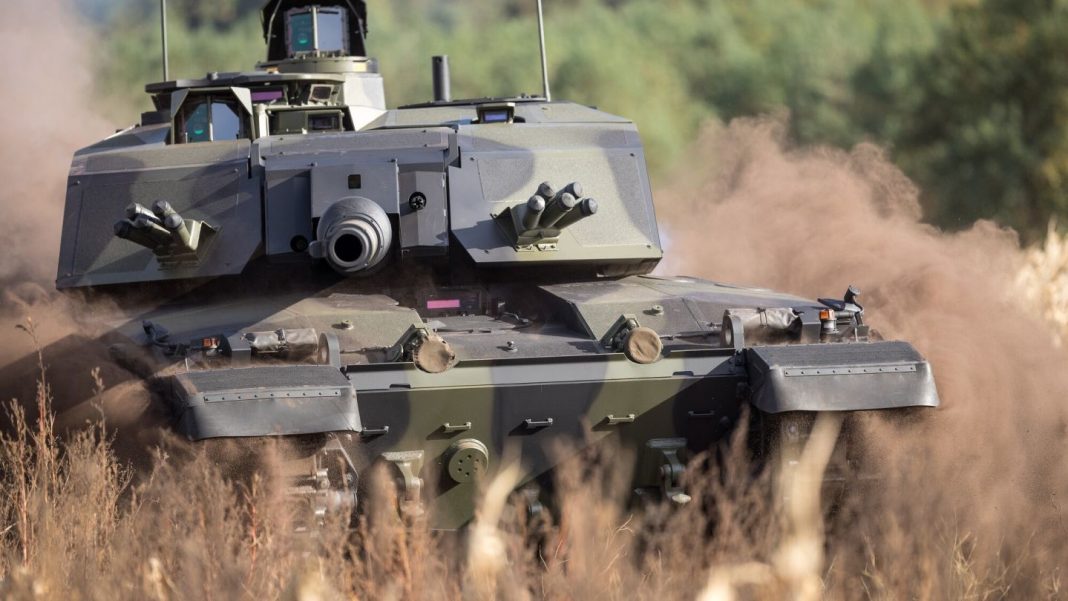Trophy Active Protection System
The Challenger 3 tank is to be protected by hard-kill system from Israel

The fleet of challengers will be reduced and comprehensively modernized.
© Commons
Britain modernizes its heavy battle tanks. The Rafael Trophy Active Protection System prevailed in active protection. The Bundeswehr also wants to equip some Leopard 2 with it.
Rheinmetall plays a central role in the upgrading of the British main battle tanks. The old Challenger 2 will be upgraded to the status “3” and, strictly speaking, completely disassembled and rebuilt with new components. The Challenger played an important role in passive protection, its chobham armor made of composite composites was groundbreaking. But today active protection systems play an equally important role. They do not help against the armor-piercing ammunition of other tanks, but against the always dangerous anti-tank missiles (ATGM). They can be moved and operated by two infantrymen, have an enormous range. Modern systems find their target even without a line of sight.
Missile threat
Bazooka and Panzerschreck from the Second World War could only be used at a very short distance, modern ATGMs hit their target from more than three kilometers. An ATGM does not blast the target with brute force, such as hard-core ammunition made of uranium or tungsten, but uses a kind of “welding beam”. Active protection intercepts them from impact. A special radar detects the incoming missile, a charge is aimed at the threat at the tower, shortly before the impact it is ignited and creates a splinter cone that shreds the approaching warhead. As for active defense systems, the Russian Armed Forces are well advanced. Since the 1990s, tanks have been equipped with the Arena system. Here, a cassette is ejected from the tower, its explosion then triggers a hail of splinters.
Now it is planned to equip the 148 Challenger-3 tanks with the Rafael Trophy Active Protection Systems (APS) active protection system. It comes from Israel and is the only system in the West that has already been tested under combat conditions. The Bundeswehr also wants to use the system on the Leopard 2 and the US will retrofit four brigades with M-1A2 SEP2 Abrams tanks.
Defense by ” shotguns”
The Trophy missile defense system can detect incoming enemy bazookas (RPG), guided missiles and other ammunition with a radar. Four flat antennas provide a 360-degree panoramic view. Just before the impact, a sleeve of the system is fired, then a whole cloud of steel balls comes out. So the weapon does not have to hit exactly, but the ignition timing must be exactly right.
This sounds simple, but in practice it is treacherous. After all, the fighting that Israel is fighting, but also that we have seen in Iraq, Syria and eastern Ukraine, are not the kind of movement battles that were practiced in the Cold War. Instead of a big tank battle, heavy battle tanks move in the middle of infantry in urban terrain. It is therefore crucial that a defense system reliably destroys an incoming missile, but the ball cloud must not kill the infantrymen in the area or shred vehicles nearby.
Colonel Will Waugh, director of the UK’s main battle tank programme, said: “This technology, which has already proved its worth among our international allies and partners, will significantly improve protection against guided and unguided anti – tank weapons-a threat that is becoming increasingly widespread and deadly worldwide.”
Proven system
The Israel Defense Forces began work on Trophy in the early 2000s. After the loss of several Merkava tanks in the 2006 Lebanon War, the system was installed in 2010. Compared to other developments, it is likely to be out of the period of teething problems. Several videos show how it has proven itself against real attacks. Among other things, it was able to repel a Kornet missile. The Kornet is originally a development of the USSR and roughly corresponds to the German Milan.
The Trophy system detects incoming projectiles through the four phased array radars, and then calculates the best time to fire back. It also tries to identify the enemy position and can align the tower with the target. In the case of connected weapon systems, these values are transmitted, so an artillery strike on the position of the opponent could immediately take place.
The states of the West urgently need to catch up here, since Russia also has experience with active defense systems and uses them not only on the most modern tank T-14 Armata, but also modernized the types T-90, T-84 and T-72 with them. NATO is currently faced with the situation that the main armament of combat tanks such as the Leopard 2 can not penetrate the frontal armor of a T-14 or a modernized T-90. And in addition, these tanks can also defend themselves against anti – tank missiles with an active protection system, while the Western models – like the Challenger 3-are only slowly following suit.
Eternal race
In the times of increasingly sophisticated anti-tank missiles and the threat of drones, heavy battle tanks without active protection have no chance in battle. Powerful defense systems should make battle tanks unassailable again, as it was in the first half of the Second World War.
Whether this succeeds remains questionable. Even today, the systems should also be able to fend off drones. And even then they could not destroy a swarm attack. In attacks with dummies, such a system quickly shoots itself empty. Therefore, even a simple armored gun like the Russian RPG-30 Krjuk can overwhelm a system like Trophy. The RPG-30 throws out two missiles in a row. Before the deadly warhead flies a dummy on the same trajectory, shortly before the target detonates the dummy and thus triggers the missile defense. The actual warhead should then get through and destroy the target.
Read also:
Germany’s answer to Putin’s super tank
The Black Night is to compete against Putin’s T-14 Armata
Putin’s new old main battle tank T-90M Proryv-3-cheap, time-tested and deadly




